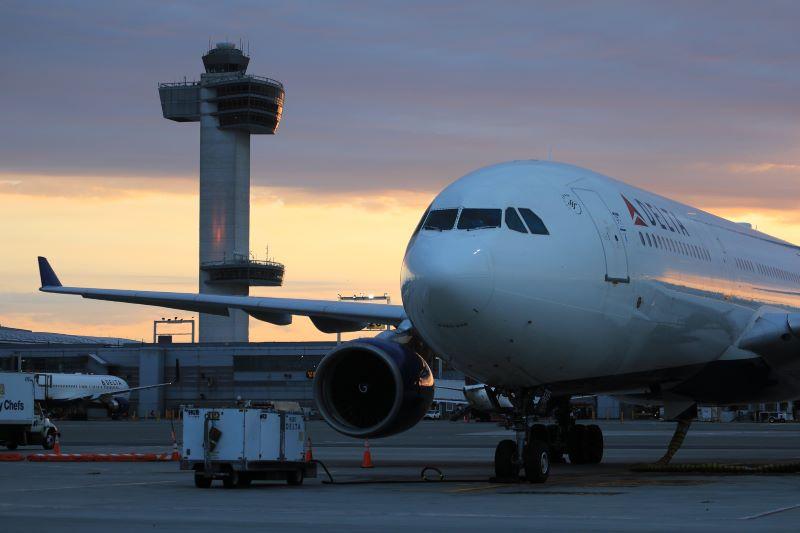
An operational summit hosted by the U.S. Federal Aviation Administration’s (FAA) Air Traffic Organization (ATO) sought ideas to improve New York-area operations in summer 2023, in anticipation of high demand on top of significant capacity constraints.
The summit brought together airlines, general aviation representatives, and the National Air Traffic Controllers Association (NATCA) to discuss improving traffic flow management strategies, system resiliency, facility staffing, and the air traffic controller training backlog. It followed an FAA ask for airlines to voluntarily reduce their summer service in the region by 10%.
“Operators requested collaboration and communication with the FAA early and often to plan for circumstances that could result in delays, including weather events, space launches and military operations,” FAA said of its March 29 summit. “They discussed how closer collaboration and frequent air traffic updates would help them more effectively schedule crews. They also requested increased coordination between facilities to take advantage of alternate routes, such as deep-water routes.”
Staffing levels at New York Terminal Radar Approach Control (N90) continue to be below targets, FAA noted.
NATCA has pointed to low hiring goals from FAA, recently adjusted, as part of the problem behind what it calls an almost 30-year low in the number of fully certified controllers across the National Airspace System (NAS). Nodding to funding instability as one of FAA’s most serious challenges in maintaining capacity, the agency has also not kept up with ATC attrition, NATCA said in March 23 testimony.
“By the end of Fiscal Year 2022, there were 1,200 fewer Certified Professional Controllers [CPCs] employed by the FAA than a decade earlier and 6% of those who remain are eligible to retire,” NATCA President Rich Santa said before the House Subcommittee on Aviation. “Recently, the FAA has upwardly adjusted its hiring goal for each of fiscal 2024-2026 to 1,800 new hires—a positive development. But, hiring more trainees in the short term will not immediately solve this staffing crisis because it takes 1-3 years of on-the-job training for controllers to become fully certified after graduating from the FAA’s training academy in Oklahoma City. Moreover, only about 60% of all controller trainees reach full certification within three years.”
In recognition of staffing challenges, NATCA noted its Collaborative Resource Workgroup (CRWG) partnership with ATO was recently relaunched to determine the number of CPCs, and necessary resources, required to meet demand. The workgroup’s report was presented to Acting Administrator Billy Nolen in mid-February, with updated staffing targets that NATCA says should not only be utilized in setting hiring goals, but also to improve distribution of the operational workforce.
In a March 22 notice of limited waiver, FAA said it was working toward moving responsibility for the Newark radar sector from N90 to the Philadelphia TRACON (PHL), with related training slated to begin in September 2023.
New York Limit
Summer operations at New York-area airports are projected to experience a 45% year-over-year increase in overall delays, according to ATO projections. During the year-ago May-September period, delay to operations from Newark (EWR) and New York’s JFK and LaGuardia (LGA) airports totaled 41,498. The three facilities had 252,099 scheduled departures during that five-month period, according to FAA’s ASPM database. FAA noted its 2023 summer projection is consistent with a 50% year-over-year increase in the number of ground delay programs observed in January and February 2023.
Warning that delays could extend beyond the region, “Due to the amount of connecting flights in the New York region as well as the interdependency and complexity of the airspace surrounding EWR, JFK and LGA,” FAA is asking airlines for help.
In a rule issued March 27, the agency grants a limited waiver of slot usage requirements “due to post-pandemic effects” on N90 ATC staffing—at high-density slot-controlled Level 3 airports JFK, LGA, and Ronald Reagan Washington National (DCA), and at EWR, a Level 2 slot facilitated airport. The FAA’s limited waiver will remain valid from May 15, 2023, through September 15, 2023, for carriers who identify the slots and timings before April 30.
The agency said it “will not reallocate the returned slots or approved operating timings at JFK, LGA, or EWR,” as it aims to reduce operational volumes.
“This relief is being provided to give carriers the ability to reduce operations during the peak summer travel period, which are likely to be exacerbated by the effects of Air Traffic Controller (ATC) staffing shortfalls,” FAA writes in its rule. The agency also expects airlines to minimize passenger impacts in other ways, including through the operation of larger aircraft, and by issuing communications about any potential disruptions.
Delta Air Lines and United Airlines have each submitted for the return of up to 10% of slots held at JFK, LGA, and DCA and approved operating times at EWR. JetBlue Airways says it also plans to decrease service to New York in light of FAA’s request.
“Unfortunately, last week the FAA announced what we have known for a long time, which is there is a significant shortage of air traffic controllers in the New York center ... with staffing levels of 54%,” CEO Robin Hayes said in March 29 remarks at the Economic Club in New York.
In a statement to Aviation Week the airline noted its disappointment in having to reduce flights, but expressed approval on FAA’s proactive approach, and transparency on staffing shortages. JetBlue said it is reviewing options for reducing its flight schedule at JFK and LaGuardia airports, and plans to share details on the scheduling reduction once its plan is finalized.
“We are advocating for Congress to provide the FAA with the funding and resources it needs to fully staff air traffic control now and for the long term, and to provide adequate funding for the FAA to invest in new modern technology that will make air traffic control more efficient,” a JetBlue spokesperson told Aviation Week. “There’s no region that will benefit more from that than New York.”
